Exploring Japan's Traditional Side
- Aaron Schorr
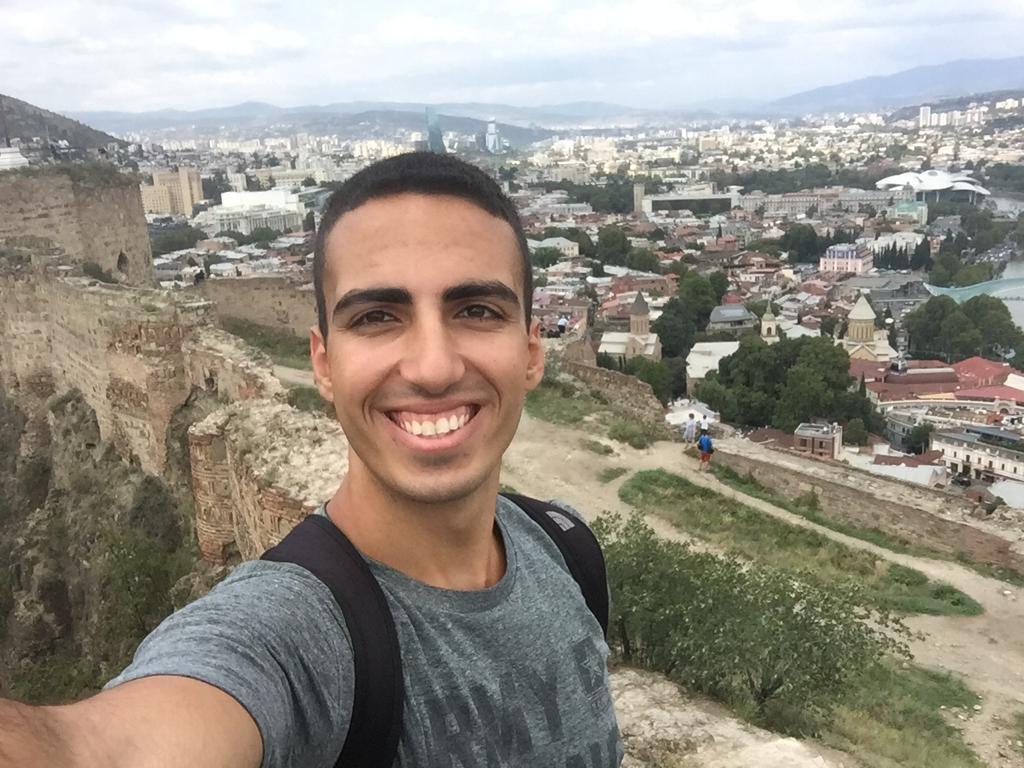
- Feb 28, 2020
- 13 min read
Updated: Feb 29, 2020
We departed Tokyo on a morning commuter train to Odawara, a small city about 50 miles south-west of Tokyo. The Tōkaidō Line route gave me a new perspective on just how big Tokyo was, taking us through endless urban development that only petered out just before arriving in Odawara over an hour later. Tokyo gave way to Shinagawa, which was followed by Kawasaki, Yokohama, and a string of smaller cities whose names were called out by the cartoonish PA voice as we pulled into each station.
The seats on the train were heated well beyond reason and I was squirming in my seat after half an hour in a vain attempt to shift the heat around. In an incredible example of Japanese politeness culture, the train car had posters advertising proper smoking etiquette paid for by none other than Japan Tobacco, a cigarette manufacturer partially owned by the Japanese government. The company has an online gallery (www.jt-manners.jp) with dozens of such posters which appear on JR trains around the country and some of them are simply precious.
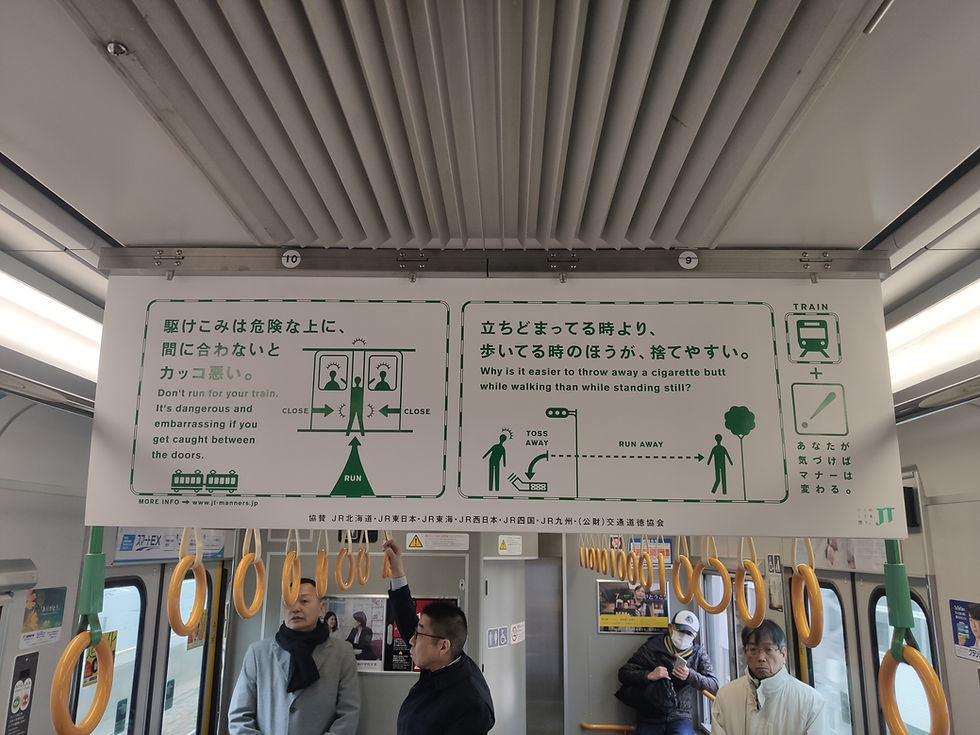

Pirate Ships with Views of Fuji
We had come to Odawara to explore Hakone, a nature reserve popular among Tokyoites for its views of Mt Fuji. ¥4,600 ($41) bought us each a pass for the many means of transportation in the area at the friendly tourist information office, where we received suggestions on the best routes to take. Armed with a small forest worth of pamphlets and timetables for what seemed like every bus and train line south of Tokyo, we took a local train up the Haya River to the town of Hakone-Yumoto. This is normally the terminus for a very scenic mountain train route called the Hakone Tozan Railway, continuing 15 kilometers further up the valley on an 8% grade track amid beautiful scenery. The train was unfortunately out of service until spring, so we had to wait in line for ages to catch the replacement bus which was much less scenic.
Next up was a cable car to Ōwakudani, a viewpoint at 1200 meters above sea level on Mt Hakone. Cresting a hill on the way up, the forested hills suddenly gave way to a fantastic view of Mt Fuji, less than 50 kilometers away in perfect visibility. The ever-stoic Japanese gasped as loudly as we did as the mountain came in to view, majestic in the crisp winter morning.
Hakoneakone is a volcano which last erupted around 3000 years ago, but still very much active. The cable car passed over a crater, yellowed with sulfur deposits and dotted with vents belching volcanic gases that left a smell even in the car.
Mt Hakone is a volcano which last erupted around 3000 years ago, but is still very much active. The cable car passed over a crater, yellowed with sulfur deposits and dotted with vents belching volcanic gases that left a smell even in the car. The top was windy and cold and we stopped for some mediocre ramen to get out of the wind after looking for the spot with the best view of Fuji.

Hakone is famous for kuro tamago, eggs soft-boiled in hot volcanic springs and blackened by the minerals, which are said to extend one's life by seven years. They look special but taste quite identical to normal soft-boiled eggs, despite fancy graphs claiming the umami flavor is 1.2 times as strong because of the hydrogen sulfide. What they do do quite well is limit the amount of time you want to spend in the mountaintop gift shop, which smells quite potently of soft-boiled eggs.

The cable car brought us back down the mountain to the northern shore of Lake Ashi, a pleasant alpine lake unfortunately ringed by mountains blocking the view of Fuji. For some reason, the Hakone transportation company must have thought the place didn't look adventurous enough and decided to add a pair of ferries modeled like pirate ships, a thoroughly strange choice for a Japanese mountain lake.

The south-eastern shore had a Shinto shrine apparently dating back to the 8th century with a torii gate emerging from the lakewater beneath it. Japanese couples are obsessed with temples, and there were literally hundreds of couples in line to take a photo under the gate; the wait must have been well over an hour.

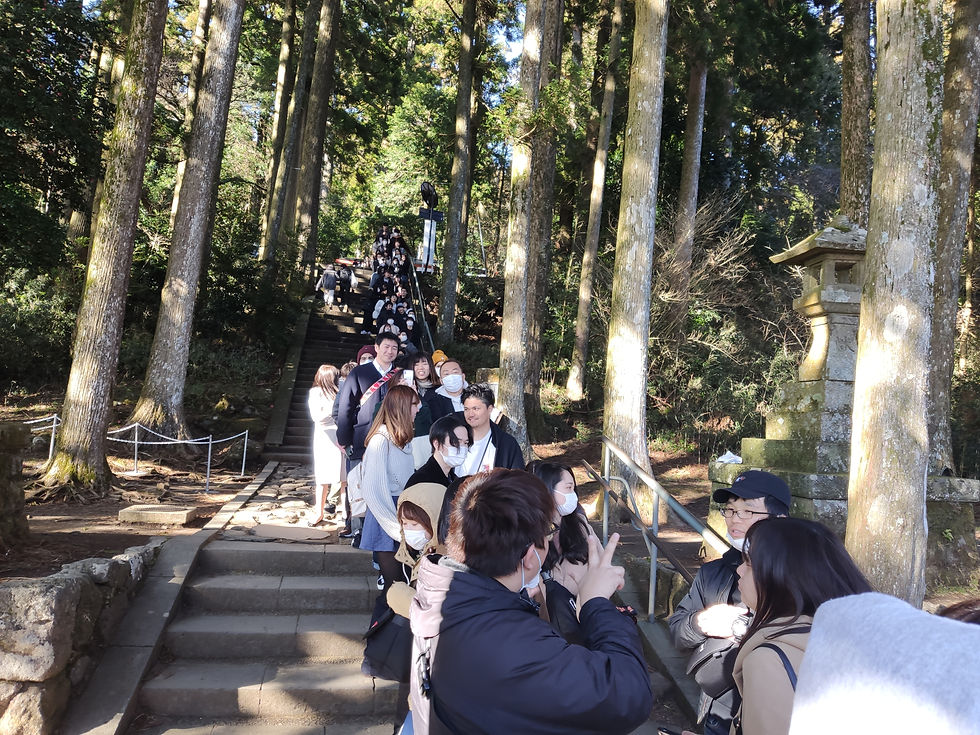
Israeli TV in Rural Japan
A bus and another ride on the Hakone Tozan Line returned us to Odawara - we were doing our damnedest to get our money's worth out of the transit pass - and we found a soba noodles restaurant for dinner. Ordering proved rather challenging, Google Translate struggling with the Japanese-only menu. I ordered noodles with either "countryside color" or "life insurance", which ended up being something I suspect used to be part of a chicken; the others were equally perplexed. A TV in the corner was showing a local news channel and something caught my eye; I nearly spat out my noodles when I looked closer and saw it was Fauda dubbed into Japanese with Hebrew subtitles.

Besides its views of Fuji, Hakone is known for its onsens, or traditional bath houses, fed by volcanic springs in the area. The area around the reserve is dotted with dozens of fancy onsens of different types, charging up to ¥5,000 ($45) per person per hour. With our backpacker budget and a desire to experience something more authentic, we found the public bath house in Odawara, operating for nearly 100 years in a nondescript building in the town center.
It's a simple onsen, with only one hot bath per gender, but the crowd was clearly local. Bathing is done strictly in the nude, which was made somewhat more uncomfortable by the elderly female receptionist sitting on an elevated chair by the entrance with a commanding view of both genders' locker rooms.
The water, on the other hand, was intoxicating, heated to 48°C and containing a high mineral content which made my skin feel brand-new. The locals actually come here to bathe, bringing soap, shampoo, and razors with them, which they use sitting on plastic buckets by rows of taps of hot and cold water after dipping in the bath. It was an awesome experience and the friends with me were the perfect people to share it with.

Train Nerd Paradise
We were back in the Odawara train station for the fourth time in 24 hours the next morning. I was in a gleeful mood, as we were taking the Shinkansen to Kyoto. The Shinkansen, the high-speed rail network that has become a symbol of modern Japan, streches for over 2,700 kilometers from Hakodate on the northern island of Hokkaido to Kagoshima, the southernmost city in Japan's Home Islands, carrying over a million passengers a day on average. Running at speeds of up to 320 km/h, the system has been the global standard for high-speed rail since its introduction, essentially defining the genre.
Close to 6 billion passengers have ridden the Shinkansen over its 55 years of operation, and not a single one of them has been killed or injured in an accident. If that isn't impressive enough, the average delay per train across the entire system in 2017 was a mere 24 seconds, including those caused by earthquakes and typhoons.
The amount of work that goes into assuring that level of safety and punctuality is astounding. A single train will go through as many as 500 different safety checks in a 3-year overhaul cycle, and the tracks are kept in pristine condition by a 3000-strong maintenance crew and a bright yellow bullet train that checks them for imperfections. As a self-proclaimed train nerd, I had been psyched to ride the world's fastest train in China, but I was equally happy to ride its spiritual ancestor from across the Sea of Japan.

Our train in question was the Hikari Express on the Tōkaidō Shinkansen line, which is both the oldest and busiest line, linking Tokyo with Osaka, Nagoya, and Kyoto, appropriately Japan's third-, fourth-, and ninth-most populous cities (the second is Yokohama, which is too close for high-speed rail). The line is a wonder of technology and efficiency, running up to 13 sixteen-car trains an hour in each direction for a total capacity of 17,200 seats, the equivalent of 115 Airbus A320s every hour.
The ride is more similar to flying than most train rides, only much more comfortable. The train car is absolutely spotless, even by Japanese standards, cleaned by an army of drilled cleaners at each end of the line in a matter of minutes. The seats are comfortable with plenty of legroom and there are large windows at each row to watch the scenery fly past at 270 km/h. Employing a track entirely lacking joints and gaps, the ride is beyond smooth and utterly silent except when accelerating out of a station. Stewardesses unobtrusively glide down the aisles with snacks, drinks, and newspapers for sale and the members of the crew politely bow when entering or exiting a car.
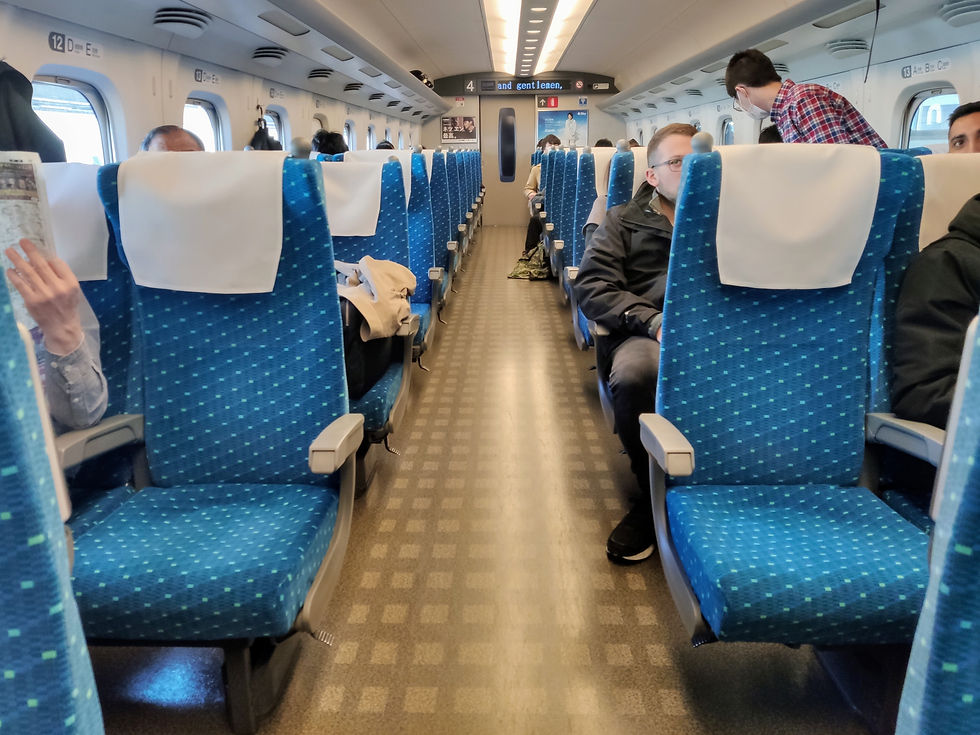
We covered the 480 kilometers to Kyoto in a mind-blowing 2 hours and 3 minutes, including 3 intermediate stops. To put that into perspective, that's the same distance as Richmond, VA, to New York, or Naharia to Eilat. All that efficiency and technology comes at a high price, though - our unreserved seats cost us ¥11,700 ($106); a one-week national pass available only to foreigners will cost you $270.
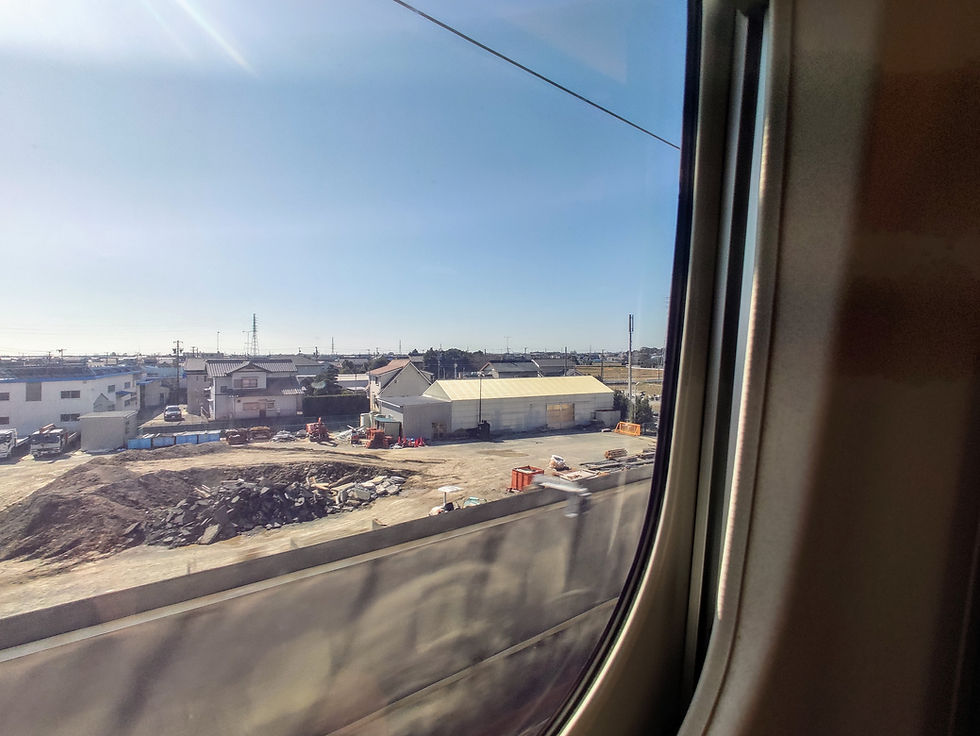
Temple Galore
Arriving in Kyoto, we took both of the city's two subway lines to reach our hostel in the historic district of Gion. Kyoto was Japan's capital for over 1000 years until 1869, when it moved to Tokyo as part of the Meiji Restoration, leaving the city with plenty of historical buildings, especially Buddhist temples and Shinto shrines. Both religions place a strong emphasis on connecting with nature, and Kyoto, located in a valley and surrounded by mountains on three sides, provided them with ample locations to do just that. The city is positively ringed with some of the most incredible shrines and temples in Japan on the lower slopes of the mountains, which makes for lovely surroundings but results in long bus trips from one site to the next.
The first afternoon was spent at Yasaka Shrine and neighboring Maruyama Park, which was undergoing construction and less than impressive. Preparations were being made for sakura season, which was expected in less than a month, since the park is one of the most visited locations in Japan for cherry blossoms.

We wandered through the narrow streets of Sannenzaka, a historic neighborhood popular with tourists, and got a feel for Kyoto, which could hardly be more different from Tokyo. Though it's home to roughly a million and a half people, Kyoto is all about traditional Japanese culture, reflected in the abundance of traditional architecture and the dramatically reduced pace of life. Even Kawaramachi, the downtown area just across the Kamo River from Gion, is almost empty at 9 pm.

The next day was my birthday, and tragically also the first really gray day we had had in Japan. We paid a visit to Kinkaku-ji, perhaps Kyoto's most photogenic temple, painted a somewhat garish gold with a perfectly still pond behind it.
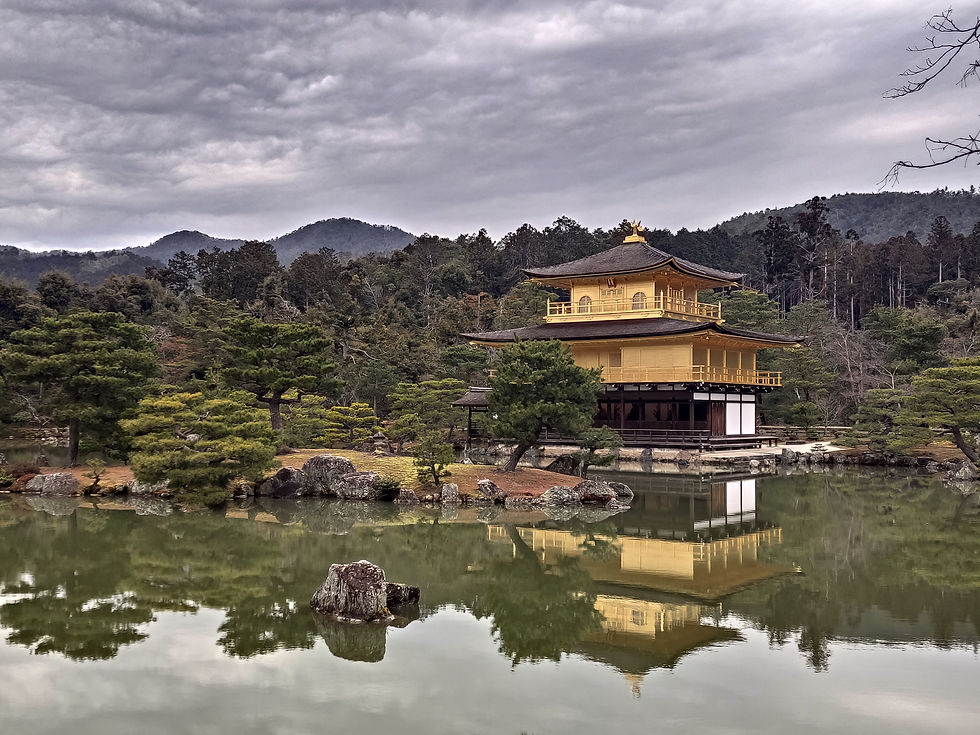

Ryōan-ji further to the west was a perfect example of Buddhist serenity, notable for its garden consisting entirely of rocks. Its wooden construction, simply-painted tatami rooms, and picturesque setting were like stepping back in time to Japan of 300 years ago, a feeling replicated in more than a few locations in and around Kyoto.
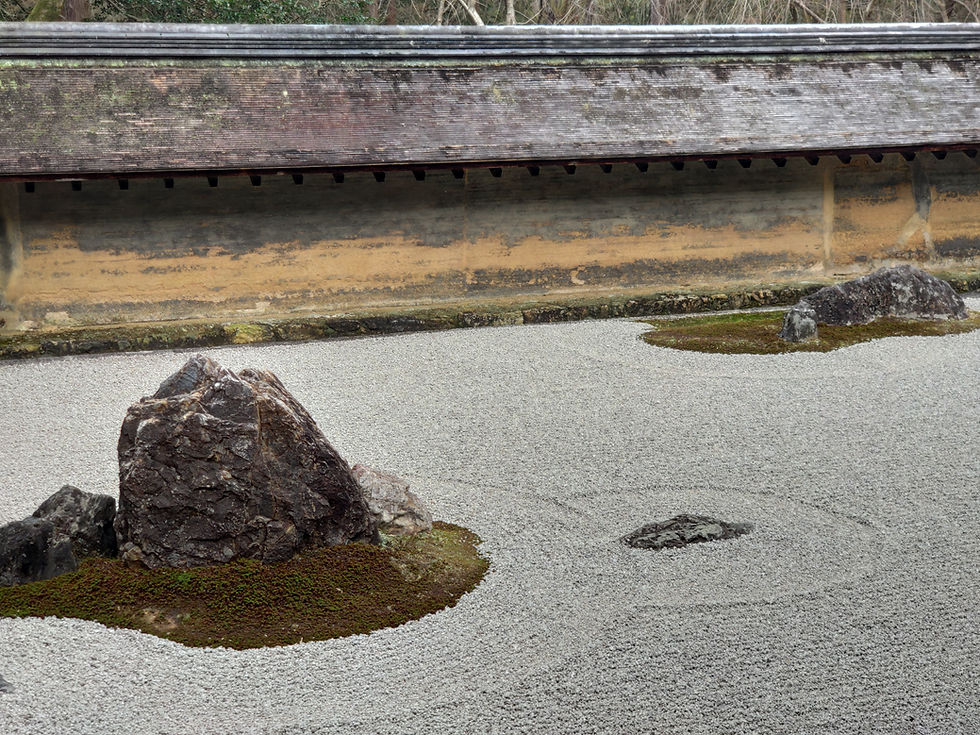

The city is full of Japanese tourists who come for spiritual sightseeing and photoshoots, renting traditional kimonos and clomping around town in socks and gets (traditional wooden flip-flops) that look hideously uncomfortable, especially descending the stairs leading to every temple.
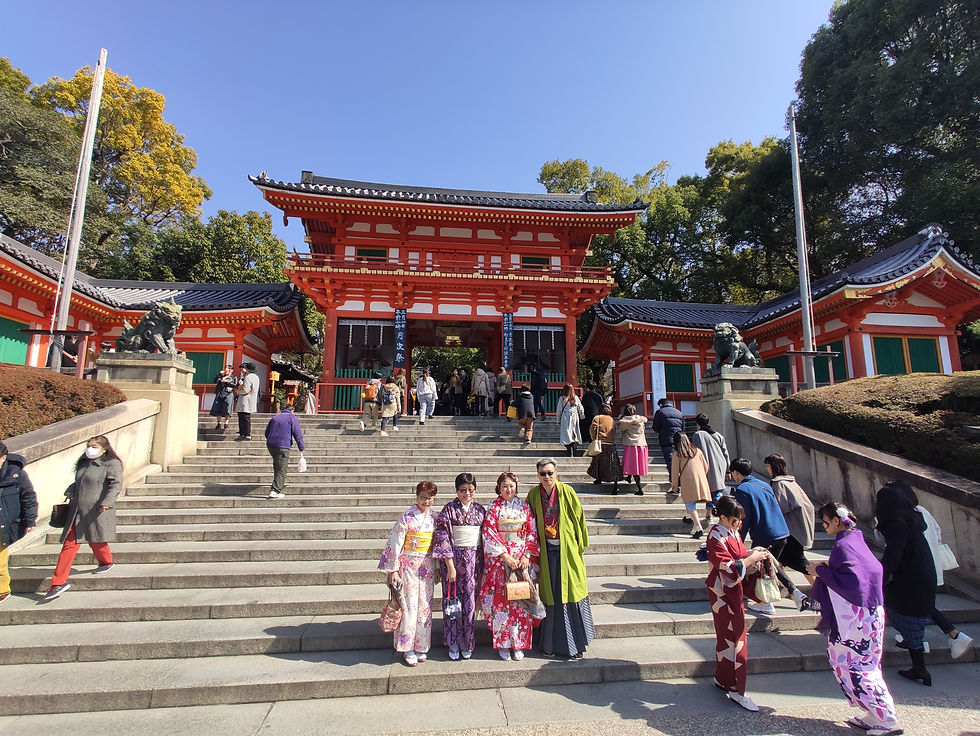
A walk through a quiet neighborhood reminiscent of a clean American suburb led us past a high school, where a group of students practicing judo waved at us from their dojo, the most emotion we had managed to provoke out of any Japanese yet. We continued west to Arashiyama, a picturesque neighborhood very popular with domestic tourists. It seemed like every Japanese couple in their 20s and 30s came here to celebrate their anniversary with a rickshaw ride.

Arashiyama had lots more temples, but more of interest to us was a grove full of massive bamboo trees, some over 20 meters high. Even the crowds of tourists couldn't really subdue the feeling of otherworldliness of being surrounded by monster trees on a wintry day.

The gray skies had gotten to us and we all felt like walking zombies by the time we returned to Gion after grinding through the rush-hour traffic for an hour on a hot bus, heading in for a nap before my planned birthday celebrations in the evening. We woke up to pouring rain, reducing said celebrations to dinner and shōchū in the hostel. It was still a nice way to finish what was probably my best year yet. Age 20 had been a wild ride, kicking off on the ski slopes of Andorra and finishing in the temples of Kyoto, with new friendships made and old ones strengthened, many life lessons learned, and my freedom regained. I have even higher hopes for 21.

Veterans of Matcha Day
The next day was all about Kyoto's fabled nature. We started off at Fushimi Inari, a temple complex on 233-meter high Mt Inari in eastern Kyoto. The complex has thousands of distinctive red torii gates lining the paths leading up the mountain to dozens of sacred sites dedicated to Inari, the Shinto god of rice. The temples attract huge numbers of tourists every day, but thankfully most of them stick to the main one at the bottom of the mountain, leaving the higher trails relatively empty and serene, with the torii gates streching hundreds of meters in either direction.

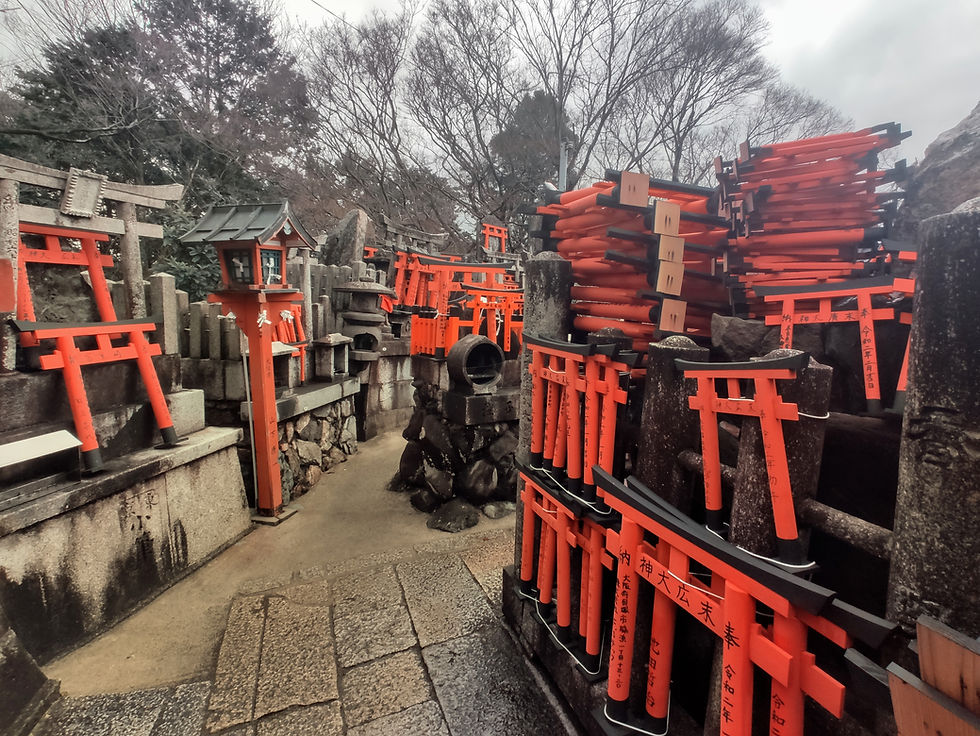
The Japanese are beyond obsessed with matcha, green tea made of a mix of ground tea leaves, and you can find almost any kind of food with the stuff. The taste is usually not the best (if I'm being generous), but Yotam and I decided to wait until after my birthday and spend an entire day exclusively eating food that contained matcha. Breakfast was a matcha latte from the drinks machine at the hostel and a matcha cake with beans from a minimarket at the subway station, which were both better than expected.
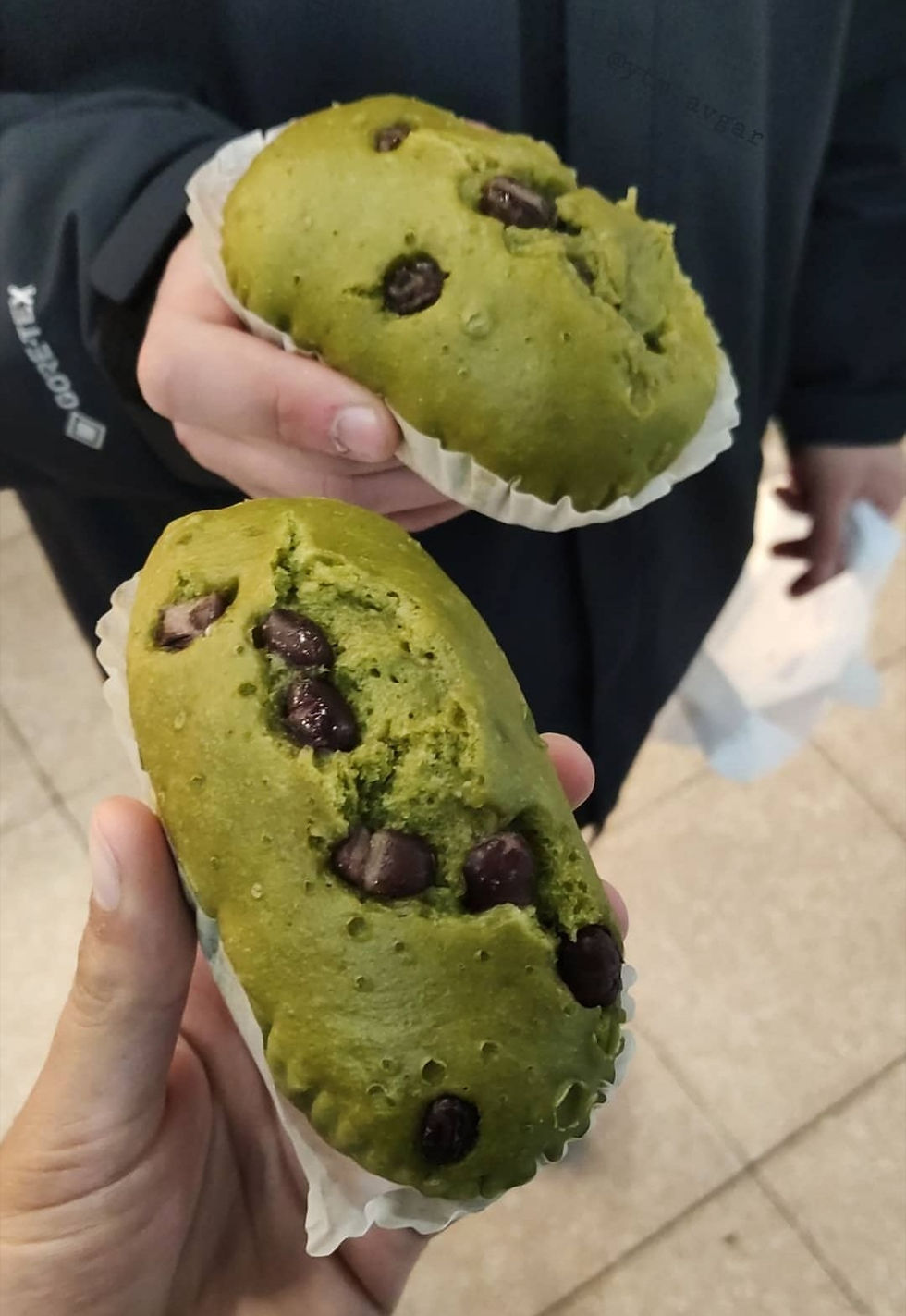
For lunch, I had found a restaurant in Kyoto's main train station specializing in tea-infused food, so we took the train from Fushimi Inari and looked for the restaurant, which turned out to be rather hard to find in the maze-like station. Roy and Peleg took a look at the menu and went to find something else to eat; Yotam and I each ordered a set menu based around matcha noodles. After being served a pot of green tea, we received trays containing matcha noodles in broth, sencha leaves to spread in the broth, rice with black tea and pickles, and green tea pudding with bean paste. It was the weirdest meal I had had in a while, but it could have been worse. To top it off, we ducked into a convenience store and bought matcha chocolate chip cookies.

Peleg had found some amazing and recent photos of plum trees in blossom on Instagram. The photos were clearly from Kyoto but we couldn't figure out where; some quick messages landed me the name of the park. A bus brought us to Jonangu Shrine in the south of the city, which had some of the most beautiful gardens we had seen in Japan. The highlight, though, was undoubtedly the plum tree garden, which was in full bloom with pink-and-white petals covering the ground like something out of a fairytale. Though we were missing sakura season, this was an amazing alternative.
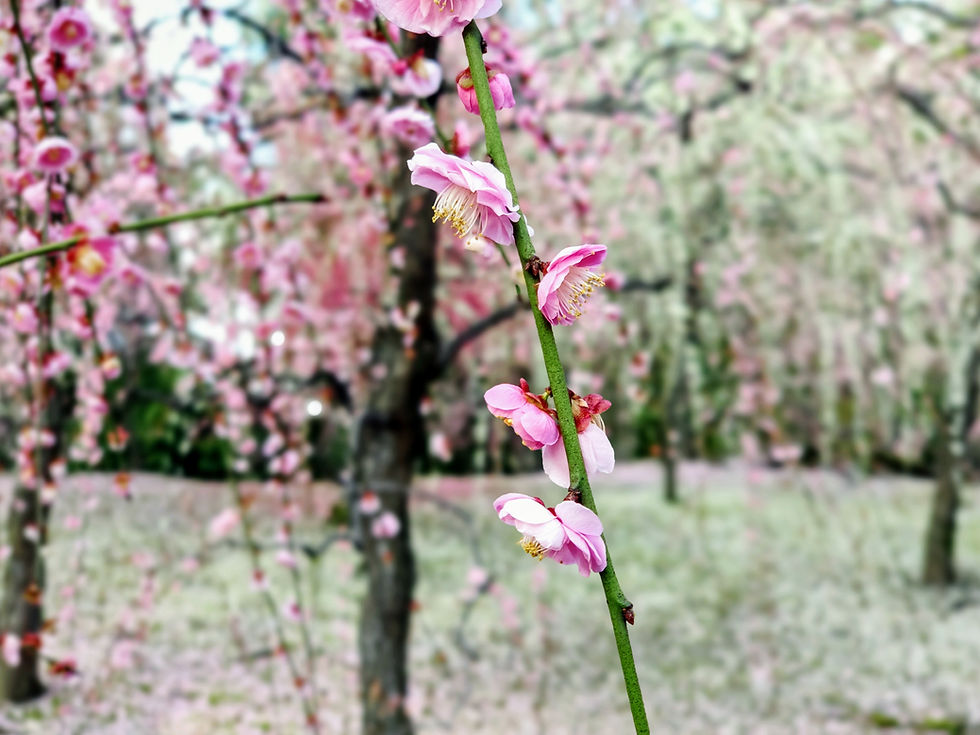
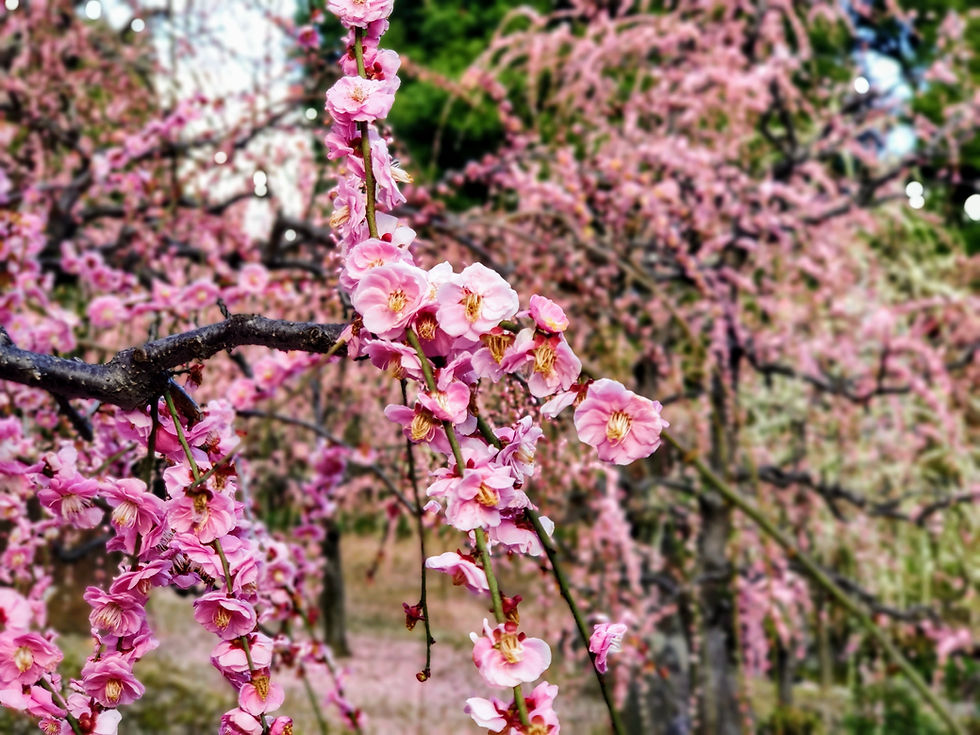
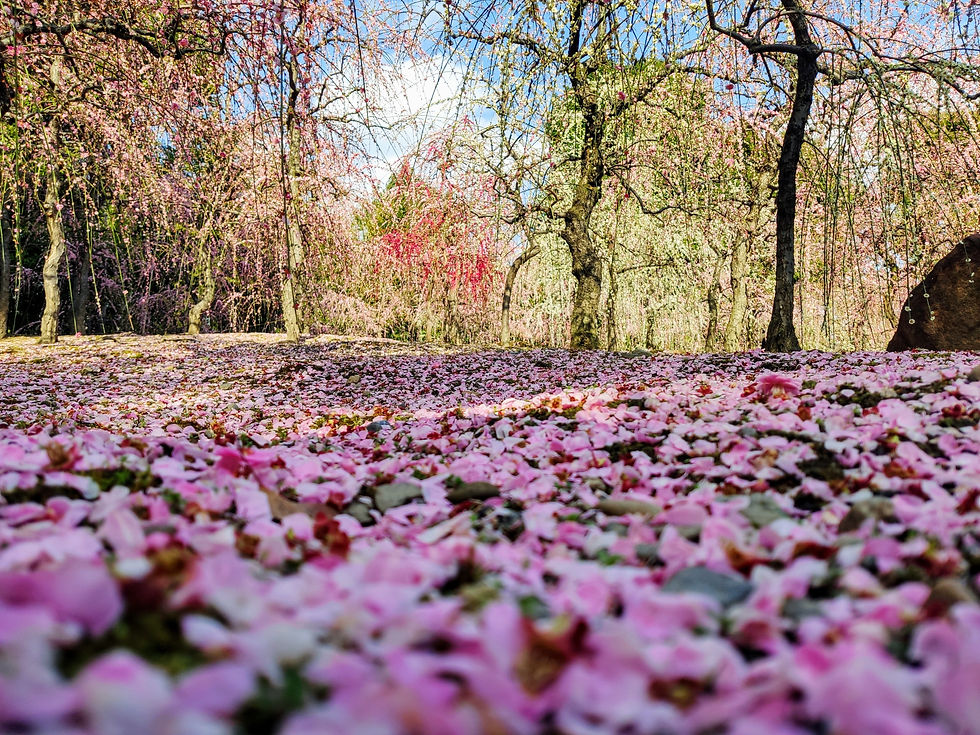
The subway took us back to Gion, where we bought panda-shaped cookies coated with matcha to commemorate the official completion of Matcha Day, the best bad idea so far on this trip. Next to our hostel was a gyoza (fried dumplings) restaurant with rave reviews; we had tried to go the previous night but had encountered a long line. This time, we showed up 10 minutes before opening time, only to find no fewer than 27 people in line ahead of us. This was bad news, considering there were only 15 seats in the restaurant, but we decided to stick it out.
We found a spot with hot air blowing on us and waited for over an hour until "Roy-sama" was called. The food was delicious but probably not worth the wait (though I did get nearly a full hour of blogging in). To make things better, we tasted umeshu (plum wine) for the first time and discovered it was our favorite Japanese alcohol yet, sweet and fresh and best served with soda on the rocks. We got a bottle from the nearby liquor store and drank it while making plans for the next day.
Japan's Largest Buddha and Highly Aggressive Deer
Our plan for the day was to visit Nara, a small city 40 kilometers to the south. We boarded a commuter train and rode through the unattractive semi-urban sprawl linking Kyoto and Nara, with the Yamato Plateau rising to the east of the tracks. Historically, Nara was an important political center, and there are plenty of temples and former palaces to visit. Most of these are concentrated east of the city center in and around Nara Park. The main attraction in Nara, however, is actually an animal, or rather animals.
Over 1,200 deer live in the park and have become the symbol of the city, with every imaginable kind of deer-themed souvenir sold to to tourists.


Despite signs warning that the deer are wild animals that may attack without warning, constant contact with humans has made the deer incredibly tame, allowing passers-by to pet them and take pictures with them as they calmly stroll around the streets surrounding the park. Some shrewd locals have started selling "deer crackers" to tourists who want to feed the deer, and that's where things start to change. Yotam bought a package of crackers and was instantly swarmed by nearly a dozen animals competing for his attention. He handed me half of them to try to split their attention and I found myself surrounded by aggressive deer, headbutting me and biting my clothes in an attempt to get some crackers. Unbeknownst to me, Yotam had stuck a cracker in my jacket pocket, which explained why they kept attacking me after I had already handed out all my crackers until I found it. It was a very unexpected adrenaline rush.
We had spent the past three days visiting temples and shrines in Kyoto and had limited attention spans for those in Nara. The one exception was Tōdai-ji, a temple with the largest statue of Buddha in Japan. We entered the temple, which had a central building much bigger than those in Kyoto, and received an explanation about the architecture from a guide who had such a thick accent it was difficult to tell whether she was speaking Japanese or English. The main thing I did understand was that the walkway leading to the temple was paved with Indian stones in the center, with Chinese, Korean, and finally Japanese stones on either side, tracing the route Buddhism followed from its inception until it reached Japan.

Inside, the statue of Buddha was indeed immense. 15 meters tall, in fact, with 2.5 meter tall ears and eyes over a meter wide, as our guide painstakingly explained. The dimensions were also explained on the admission ticket in case you missed the explanation - they clearly didn't want anyone challenging their "largest in the country" claim.

Another Train Nerd Paradise
The weather was getting worse, with really cold wind and intermittent rain, so we got some sushi and returned to Kyoto. During our search for the matcha restaurant the previous day, we had spotted a bakery in the main station that had looked amazing and made our way back to confirm our suspicions. It turned out to have some of the best pastries I've had in years, and I was happy this was our last day in Kyoto because I would otherwise be coming back again and again.
My final item on the list of things I wanted to do in Kyoto was the railway museum. Peleg and Yotam were tired and dropped out upon seeing the ¥1,200 ($11) entry fee, leaving only Roy with me as I became a little kid again upon entering the museum. The Shinkansen is practically an object of religious reverence in this country, and it was on display everywhere - from mechanical parts of the train on display, through explanations about the electrical systems and maintenance vehicles, to simulations of different safety features. There was even a transparent ticket machine on display, which finally explained how the ticket machines here always return your ticket the right way in a split second, regardless of how you feed them in. I could have spent the entire day there.







Comments